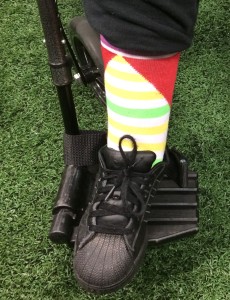So, my cousin, Ariel (the same one who drove me to Barwis) is in college and she is a GREAT writer and an honor student. She wrote about me for one of her classes. I was not only flattered that she chose to write about me, but I was so pleased with what she wrote… WOW!!!!
Check it out:
Ariel Guevara
JOUR 131
Dr. Kim
Fall 2015
Feature/Profile
Who: Jennifer Rios
What: A single mother and Detroit English teacher living with MS.
Why: To inform readers about MS and to spread awareness about the need for ADA regulations to be upgraded.
How: An interview with her.
Significance: Jennifer is a single mother and a teacher who inspires others with her ability to cope with her illness and succeed despite it. She hopes to spread awareness about the failings of the ADA to truly make the world more accessible for people with disabilities.
Sources:
Rios, Jennifer. “Not Spinning My Wheels.” Not Spinning My Wheels. N.p., n.d. Web. 14 Nov. 2015. <http://notspinningmywheels.com/>.
“What Is MS?” National Multiple Sclerosis Society. N.p., n.d. Web. 14 Nov. 2015. <http://www.nationalmssociety.org/What-is-MS>.
Disabled People Matter Too
“You have MS. You’re going to go blind and then you’re going to die.” This is how a doctor broke the news to Jennifer Rios who was only 18 when she found out she had been diagnosed with Multiple Sclerosis (MS). To that doctor, Jennifer says, “I’m not dead yet!” In fact, she is far from dead. Despite having what she calls “a really mean disease,” Jennifer is raising her son by herself, teaching struggling students to read, and working on gaining the strength to walk again.
According to the National Multiple Sclerosis Society, Multiple Sclerosis is a disease that disrupts the flow of information between the brain and the body. Essentially, those living with MS lose the ability to control their own bodies. Jennifer’s MS has mostly affected her legs, leaving her wheelchair-bound. “It’s definitely not something I would wish on my worst enemy,” says Jennifer who goes on to describe the near constant pain she experiences and a numbness in her legs that she can’t quite find the words to explain. “This really hurts,” Jennifer admits, although she says she tries not to acknowledge the pain because she has other things to do and can’t afford to dwell on it.
Jennifer is often told that she is inspirational by people who marvel at her ability to persevere and continue working through her disease, but she doesn’t see it that way. For her, living with MS is not something she does to inspire others; she does it because she has to. “I have a son who’s in eighth grade and I still have to get through the high school years! Not working is not an option.” She adds that her MS is both an afterthought and a forethought in that she has things she has to accomplish outside of coping with the disease though it affects every part of her life. “It’s gonna hurt whether I’m at home or I’m at work, so I might as well be getting paid for it!” Jennifer describes her disease as an obstacle that she has no other choice but to work around.
When it comes to her work, Jennifer is dedicated teacher. As the Reading Specialist at the Cesar Chavez Middle School in Detroit, MI, she often works from the ground up, teaching struggling students to read. Before she can do that, though, she has to make it to work and even that requires a lot of effort. When describing a typical work day, Jennifer says that she starts getting ready at about 4:15 a.m. when her mom arrives at her house to help her out of bed and into the bathroom which is not accessible. “My house was built in 1951, and in 1951, people in wheelchairs didn’t own houses or live by themselves,” Jennifer laughs. The process after she gets into the bathroom takes almost two hours. “My hair is still wet, I have my clothes on, and I am officially tired at 6:30.” Still, Jennifer travels from Dearborn to southwest Detroit five days a week, teaches until school lets out, and then grades papers while waiting for her mom to pick her back up.
To her students, Jennifer expresses a great deal of gratitude. “They’re really understanding,” she says. “I have never struggled with the door in 11 years because the kids always open it for me.” Jennifer even adds that her MS helps her students relate to her even though they don’t deal with the same struggles that she does. “I think it humanizes me to them,” she says and adds that her students feel less vulnerable about their inability to read when they’re working with a person who has visible disabilities. “I love giving them the ability to read […] That’s really cool.” For Jennifer, the silver lining to her situation is that it hasn’t hindered her ability to do her job. As she says, “You can teach a kid to read from a wheelchair.” She does explain that there have been plenty of awkwardly funny situations stemming from mishaps with students. “Every year probably about four or five sixth graders end up in my lap because they’re running and not paying attention in the halls and they run right into me and I catch them. They’re so apologetic […] and they just kind of laugh that embarrassed laugh.” She also admits that she has accidentally run over her fair share of toes.
Jennifer also has a strong relationship with her son, Sean. She decided she wanted a child immediately after finding out that she had MS, remembering that her mother’s coworker had MS and couldn’t have children because of her deteriorating condition. “I always knew I needed to be a mother, probably because my mom’s the best in the world,” Jennifer recalls. She says she wanted to have a baby before she could get to that point. She was 18 when she said, “‘I’m gonna have a baby,” and she was 19 when she gave birth to her son. When describing her relationship with Sean, Jennifer smiles and says, “We’re a team.”
When asked if Americans with Disabilities Act (ADA) regulations are effective enough, Jennifer replies that they’re not. Though she says they have come a long way, she thinks there are still ways in which our society can be more inclusive towards people with disabilities. “Accessibility is just a list that contractors are checking off,” says Jennifer who finds the most problems with public restrooms. Of contractors again, she says, “[…] They don’t think about a person who does not have control of their body having to use the public restroom.” The sinks are usually so high that she has to lift her arms until her elbows are at her ears, just to wash her hands. Even simple things like a garbage can too close to the door can become a new challenge for a person in a wheelchair. Another thing that bothers her is when she finds a baby changing station inside the only extra-wide stall. “What if there’s a baby who really needs a diaper changed and a disabled person? Who takes priority?” Jennifer asserts that disabled people need to be made contracting consultants when building plans are being made so that situations like that don’t happen. Jennifer says that someone in a wheelchair would know to make a door wide enough for them to fit through even when their elbows are out because they have to wheel themselves.
There are local businesses that are extremely considerate towards the struggles of disabled people. Jennifer mentions a local Potbelly that has gone above and beyond to make going out a little easier for them. The one she talks about features a special, shortened counter that she can roll right up to and ring a bell to let employees know that she’s there. The same store even has a special way of stocking drinks in the coolers so that they resemble a palindrome which makes it easy for disabled people to get to them. “Everything that’s on the top shelf is also on the bottom shelf,” meaning that people in wheelchairs can grab any drink they want for themselves without having to ask someone else to get it for them. Jennifer particularly loves that the restaurant has handicap seating where one side of the table is completely open so that she can sit there comfortably with her son. These considerations are proof that public places can be made to accommodate people with disabilities.
As for herself, Jennifer remains optimistic. She works with trainers up to three days a week to stretch and exercise the muscles in her legs, and she keeps others up to date on her progress by sharing her experiences on her blog, Not Spinning My Wheels. Jennifer says of her progress, “… All the work I’m doing at Barwis, my legs are slowly waking up. I’m slowly gaining control of my muscles. You know, I can wiggle my toes.”


